Urban Ecosystem Services (UES) Assessment within a 3D Virtual Environment: A Methodological Approach for the Larger Urban Zones (LUZ) of Naples, Italy
Abstract
1. Introduction
- −
- The unsuitability of representing multiple services at the same location within a unique map and the loss of aggregated information regarding the change in service bundles through time and space [26];
- −
- The impossibility of simultaneously visualising UES trade-offs [36] (i.e., those linked to the imbalance of a spatial policy maximising economic capital to the detriment of ecological services);
- −
- The difficulty of representing spatial relationships among z-elevation values and specific UES, such as the relationships useful for quantifying biodiversity loss within ecological modelling studies [37] or the spatial correlations among building z-values and other Urban Heat Island (UHI) indicators [38];
- −
- The lack of combining visual and non-visual information for the participatory assessment of scenarios in workshops [39].
- −
- How can 3D GIS-based modelling better transfer relevant information to inform decision-makers about the localisation, assessment, and management of UES?
- −
- What is the role of 3D modelling and virtual decisional environments concerning the communication, democratisation, and negotiation of UES?
2. Materials and Methods
- −
- The resolution of spatial problems that involve the allocation of resources/services in a high-density context;
- −
- The 3D UES visualisation of indicator values at multiple scales and locations;
- −
- The spatial assessment of multiple scenarios related to stakeholder preferences within a virtual decision-making environment;
- −
- The development of a dynamic web-GIS platform, through which planning demands and “integrated evaluation” tools can be matched with one another.
2.1. Technology and Tools for 3D Modelling
3. Quantification, Assessment, and 3D Visualisation of UES in Naples
3.1. Case Study
3.2. Classification of UES
- −
- Regulation, considering a group of functions related to the capacity of natural and semi-natural ecosystems to regulate essential ecological processes and life support systems through biogeochemical cycles and other biosphere processes. Regulation functions maintain a “healthy” ecosystem at different scale levels and provide the necessary pre-conditions for all other functions.
- −
- Carrier, including a group of functions related to different human activities (e.g., cultivation, habitation, and transportation) that require space and a suitable substrate (soil) or medium (water or air) to support the associated infrastructure, involving the permanent conversion of the original ecosystem.
- −
- Information, selecting essential “reference functions” that contribute to the maintenance of human health by providing opportunities for reflection, spiritual enrichment, cognitive development, recreation, and aesthetic experience.
- −
- Environmental protection area includes the surface per cell of Italian communitarian interest sites (SIC) and special protection zones (ZPS). These areas provide a relevant contribution to the maintenance/conservation of regulation services.
- −
- Waterbody shows the surface per cell of the sea, lakes, fish ponds (natural or artificial), and rivers. For specific locations, this indicator is a disservice, as the quality of water in proximity to urban centres is frequently compromised by pollution. Nevertheless, this contribution does not provide detailed data about this phenomenon.
- −
- Forest includes both protected and non-protected areas that provide a positive contribution to urban ecosystems in terms of biological exchanges, air quality, raw materials, and green footprints.
- −
- Land without current use refers to the abandoned areas that, if correctly managed, can improve the regulation service maintenance/conservation.
- −
- Waterway includes streams, drains, docks, and canals and was obtained by computing the values of the distance between the cell and the nearest waterway.
- −
- Railway shows the network of transportation by computing the values of the distance between the cell and railway tracks.
- −
- Roads contains the network of roads by computing the values of the distance between the cell and roads.
- −
- Airport shows the surfaces on which airports are allocated and the buffer of influence for the surrounding areas. Although airports are crucial for long-distance connections, they have a negative impact, in terms of noise and environmental disturbance, on ecosystems.
- −
- Port shows the surface of the coast addressed to port functions and the buffer of influence for the surrounding areas, in terms of noise, pollution, transportation of people and wares, and proximity to boarding points.
- −
- Bus/underground stop identifies the location of bus or metro stops, visualising the most accessible zones of the focus area.
- −
- Mineral extraction site shows the areas in which raw materials are extracted for the construction sector.
- −
- Habitation density shows an institutional data set provided by the EEA with information about housing density.
- −
- Waste disposal localises the waste disposals that gather waste from the study area.
- −
- Tourism facility identifies the highest concentration of the touristic facility points (e.g., hotels, B&Bs, and guesthouses).
- −
- Cultural site highlights cultural heritage by identifying the number of cultural sites.
- −
- Place of worship shows the location of worship places, which are related to landscape spiritual values.
- −
- Sport and leisure contains sport and leisure surfaces, which are very important as they contribute to the regulation and cultural functions of the landscape.
- −
- Green urban area refers to green areas, which are very important in contributing to regulation and cultural functions.
- −
- Attraction place represents the places of attraction that polarise the flows of tourists and citizens (e.g., theatres, cinema, and observatories).
- −
- Attractive landscape feature represents an excerpt of a point pattern, based on a code that determines the places most photographed by citizens and tourists in the focus area. It simulates landscape attractiveness, as perceived by citizens or tourists. A perceptual investigation about the relationship between aesthetic value and landscape features would require surveys, which the authors have not provided in this contribution.
3.3. Multi-Criteria Decision Analysis through the Spatial AHP Method
- Bundling tiers in three thematic groups, referring to the Regulation, Carrier, and Information macro-categories;
- Choosing the DT per criterion/tier (the DT determines the maximum weight for a cell touched by a tier; the weight decreases linearly, down to zero at the boundaries of the setting distance);
- Weighting tiers through AHP pairwise comparisons at three levels (in this application, the Equal Weights method was used);
- Scoring tiers with the weighted sum, in order to derive the overall results for each macro-category.
- −
- A matrix (5 × 5) for tiers within the Regulation Services “macro-category”;
- −
- A matrix (9 × 9) for tiers within the Carrier Services “macro-category”;
- −
- A matrix (6 × 6) for tiers within the Information Services “macro-category”.
- −
- A matrix (2 × 2) within the “Environmental protection area” category, which includes SIC and ZPS as polygonal items;
- −
- A matrix (4 × 4) within the “Waterway” category, which includes streams, drains, docks, and canals as polygonal items;
- −
- A matrix (14 × 14) within the “Railway” category, which includes yards, turntables, trams, subways, stations, rails, platforms, funiculars, monorails, narrow-gauge lines, abandoned lines, construction lines, disused lines, and light-rails as linear items;
- −
- A matrix (10 × 10) within the “Roads” category, which includes bridleways, cycleways, footways, motorways, pedestrian ways, pathways, steps, secondary roads, trunks, and tracks as linear items;
- −
- A matrix (2 × 2) within the “Bus/underground stop” category;
- −
- A matrix (4 × 4) within the “Tourism facility” category, which includes hotels, hostels, guest-houses, and campsites as point items;
- −
- A matrix (4 × 4) within the “Attraction place” category, which includes theatres, cinemas, and observatories as point items.
3.4. Operational Steps for 3D Modelling
- Perform a random point pattern within the polygonal footprints of the building shapefile. The maximum number of points per polygon within the random process was set as 50, depending on the features of the shapes and computational power. Points lying inside the boundaries of a building polygon had the same object identifier.
- Assign surface information derived from DSM elevation data to each point pattern within the polygons through an average statistical interpolation.
- Create a join table operation to arrange point surface information with respect to building polygons.
- Use building z-values as extrusion values and show the elevation information (in metres above sea level) in ArcGlobe 10.3.
4. Outcome
- Assessing the multi-functionality levels per MMU of 25 hectares (500 × 500 m cell size, depending on the average dimension of the Naples districts; the overall dimension of the focus area, which is a multiple of the square cell; and the PC computational power);
- Visualising the spatial distribution of services by applying the Euclidean distance method;
- Planning scenarios for the spatial implementation of UES by considering the degree of suitability per MMU.
5. Discussion
- −
- The static visualisation of the maps, which requires complex processing and cannot be changed quickly for an interactive decision-making process;
- −
- The lack of different scenarios to be compared, as it is not feasible when equal weights have been assigned to spatial criteria (tiers);
- −
- Time-consuming processes related to the manipulation of stakeholder preferences and the sensitivity analysis (i.e., introducing or removing tiers, as influenced by stakeholder interests);
- −
- Loss of relevant information, data noise, and likely overfitting if the criteria/tiers are multiple or dispersed on several geographical entities.
6. Conclusions
Author Contributions
Funding
Acknowledgments
Conflicts of Interest
References
- EU. Biodiversity Strategy for 2030. Bringing Nature Back into Our Lives. Available online: https://eur-lex.europa.eu/legal-content/EN/TXT/?qid=1590574123338&uri=CELEX:52020DC0380 (accessed on 18 July 2020).
- OECD. Biodiversity: Finance and the Economic and Business Case for Action. Report Prepared for the G7 Environment Ministers’ Meeting. 5–6 May 2019. Available online: https://www.oecd.org/env/resources/biodiversity/biodiversity-finance-and-the-economic-and-business-case-for-action.htm (accessed on 18 July 2020).
- Potschin, M.; Haines-Young, R. Defining and measuring ecosystem services. In Routledge Handbook of Ecosystem Services; Potschin, M., Haines-Young, R., Fish, R., Turner, R.K., Eds.; Routledge: London, UK; New York, NY, USA, 2016; pp. 25–44. [Google Scholar]
- Ghazoul, J. Recognising the complexities of ecosystem management and the ecosystem service concept. Gaia-Ecol. Perspect. Sci. Soc. 2007, 16, 215–221. [Google Scholar] [CrossRef]
- Costanza, R. Ecosystem services: Multiple classification systems are needed. Biol. Conserv. 2008, 141, 350–352. [Google Scholar] [CrossRef]
- Norgaard, R.B. Ecosystem services: From eye-opening metaphor to complexity blinder. Ecol. Econ. 2010, 69, 1219–1227. [Google Scholar] [CrossRef]
- Lang, D.J.; Wiek, A.; Bergmann, M.; Stauffacher, M.; Martens, P.; Moll, P.; Swilling, M.; Thomas, G.J. Transdisciplinary research in sustainability science: Practice, principles, and challenges. Sustain. Sci. 2012, 7, 25–43. [Google Scholar] [CrossRef]
- Abson, D.J.; von Wehrden, H.; Baumgärtner, S.; Fischer, J.; Hanspach, J.; Härdtle, W.; Heinrichs, H.; Klein, A.M.; Lang, D.J.; Martens, P.; et al. Ecosystem services as a boundary object for sustainability. Ecol. Econ. 2014, 103, 29–37. [Google Scholar] [CrossRef]
- Costanza, R. Social Goals and the Valuation of Ecosystem Services. Ecosystems 2000, 3, 4–10. [Google Scholar] [CrossRef]
- Costanza, R. Valuing natural capital and ecosystem services toward the goals of efficiency, fairness, and sustainability. Ecosyst. Serv. 2020, 43, 101096. [Google Scholar] [CrossRef]
- MEA. Ecosystems and Human Well-being: Synthesis; Island Press: Washington, DC, USA, 2005. [Google Scholar]
- Zermoglio, M.F.; Biggs, R.; Vicente, L. The Multiscale Approach. Ecosyst. Hum. Well Being 2005, 61. [Google Scholar]
- Gómez-Baggethun, E.; Barton, D.N. Classifying and valuing ecosystem services for urban planning. Ecol. Econ. 2013, 86, 235–245. [Google Scholar] [CrossRef]
- Larondelle, N.; Haase, D. Urban ecosystem services assessment along a rural–urban gradient: A cross-analysis of European cities. Ecol. Indic. 2013, 29, 179–190. [Google Scholar] [CrossRef]
- Kremer, P.; Hamstead, Z.; Haase, D.; McPhearson, T.; Frantzeskaki, N.; Andersson, E.; Kabisch, N.; Larondelle, N.; Rall, E.L.; Voigt, A. Key insights for the future of urban ecosystem services research. Ecol. Soc. 2016, 21, 21. [Google Scholar] [CrossRef]
- Kourdounouli, C.; Jönsson, A.M. Urban ecosystem conditions and ecosystem services–a comparison between large urban zones and city cores in the EU. J. Environ. Plan. Manag. 2020, 63, 798–817. [Google Scholar] [CrossRef]
- Tan, P.Y.; Zhang, J.; Masoudi, M.; Alemu, J.B.; Edwards, P.J.; Grêt-Regamey, A.; Richards, D.R.; Saunders, J.; Song, X.P.; Wong, L.W. A conceptual framework to untangle the concept of urban ecosystem services. Landsc. Urban. Plan. 2020, 200, 103837. [Google Scholar] [CrossRef] [PubMed]
- Luederitz, C.; Brink, E.; Gralla, F.; Hermelingmeier, V.; Meyer, M.; Niven, L.; Panzer, L.; Partelow, S.; Rau, A.; Sasaki, R.; et al. A review of urban ecosystem services: Six key challenges for future research. Ecosyst. Serv. 2015, 14, 98–112. [Google Scholar] [CrossRef]
- Antognelli, S.; Vizzari, M. Ecosystem and urban services for landscape liveability: A model for quantification of stakeholders’ perceived importance. Land Use Policy 2016, 50, 277–292. [Google Scholar] [CrossRef]
- Vejre, H.; Jensen, F.S.; Thorsen, B.J. Demonstrating the importance of intangible ecosystem services from peri-urban landscapes. Ecol. Complex. 2010, 7, 338–348. [Google Scholar] [CrossRef]
- Ostrom, E. A General Framework for Analyzing Sustainability of Social-Ecological Systems. Science 2009, 325, 419–422. [Google Scholar] [CrossRef]
- Ahern, J.; Cilliers, S.; Niemelä, J. The concept of ecosystem services in adaptive urban planning and design: A framework for supporting innovation. Landsc. Urban. Plan. 2014, 125, 254–259. [Google Scholar] [CrossRef]
- Boumans, R.; Roman, J.; Altman, I.; Kaufman, L. The Multiscale Integrated Model of Ecosystem Services (MIMES): Simulating the interactions of coupled human and natural systems. Ecosyst. Serv. 2015, 12, 30–41. [Google Scholar] [CrossRef]
- Haase, D.; Larondelle, N.; Andersson, E.; Artmann, M.; Borgström, S.; Breuste, J.; Gomez-Baggethun, E.; Gren, Å.; Hamstead, Z.; Hansen, R.; et al. A Quantitative Review of Urban Ecosystem Service Assessments: Concepts, Models, and Implementation. AMBIO 2014, 43, 413–433. [Google Scholar] [CrossRef]
- Costanza, R.; de Groot, R.; Braat, L.; Kubiszewski, I.; Fioramonti, L.; Sutton, P.; Farber, S.; Grasso, M. Twenty years of ecosystem services: How far have we come and how far do we still need to go? Ecosyst. Serv. 2017, 28, 1–16. [Google Scholar] [CrossRef]
- De Groot, R.S.; Alkemade, R.; Braat, L.; Hein, L.; Willemen, L. Challenges in integrating the concept of ecosystem services and values in landscape planning, management and decision making. Ecol. Complex. 2010, 7, 260–272. [Google Scholar] [CrossRef]
- Klein, T.M.; Celio, E.; Grêt-Regamey, A. Ecosystem services visualization and communication: A demand analysis approach for designing information and conceptualizing decision support systems. Ecosyst. Serv. 2015, 13, 173–183. [Google Scholar] [CrossRef]
- Elliot, T.B.; Almenar, J.B.; Niza, S.; Proença, V.; Rugani, B. Pathways to Modelling Ecosystem Services within an Urban Metabolism Framework. Sustainability 2019, 11, 2766. [Google Scholar] [CrossRef]
- Adda, P.; Mioc, D.; Anton, F.; McGillivray, E.; Morton, A.; Fraser, D.; Eb, C. 3D flood-risk models of government infrastructure. In Proceedings of the WebMGS 2010: 1st International Workshop on Pervasive Web Mapping, Geoprocessing and Services, Como, Italy, 26–27 August 2010; Volume XXXVIII-4, pp. 6–11. [Google Scholar]
- Middel, A.; Häb, K.; Brazel, A.J.; Martin, C.A.; Guhathakurta, S. Impact of urban form and design on mid-afternoon microclimate in Phoenix Local Climate Zones. Landsc. Urban. Plan. 2014, 122, 16–28. [Google Scholar] [CrossRef]
- Balzan, M.V.; Caruana, J.; Zammit, A. Assessing the capacity and flow of ecosystem services in multifunctional landscapes: Evidence of a rural-urban gradient in a Mediterranean small island state. Land Use Policy 2018, 75, 711–725. [Google Scholar] [CrossRef]
- Cerreta, M.; Panaro, S. From Perceived Values to Shared Values: A Multi-Stakeholder Spatial Decision Analysis (M-SSDA) for Resilient Landscapes. Sustainability 2017, 9, 1113. [Google Scholar] [CrossRef]
- Geneletti, D. Reasons and options for integrating ecosystem services in strategic environmental assessment of spatial planning. Int. J. Biodivers. Sci. Ecosyst. Serv. Manag. 2011, 7, 143–149. [Google Scholar] [CrossRef]
- Cerreta, M.; Poli, G. Landscape Services Assessment: A Hybrid Multi-Criteria Spatial Decision Support System (MC-SDSS). Sustainability 2017, 9, 1311. [Google Scholar] [CrossRef]
- Scorza, F.; Pilogallo, A.; Saganeiti, L.; Murgante, B.; Pontrandolfi, P. Comparing the territorial performances of renewable energy sources’ plants with an integrated ecosystem services loss assessment: A case study from the Basilicata region (Italy). Sustain. Cities Soc. 2020, 56, 102082. [Google Scholar] [CrossRef]
- Grêt-Regamey, A.; Celio, E.; Klein, T.M.; Wissen Hayek, U. Understanding ecosystem services trade-offs with interactive procedural modeling for sustainable urban planning. Landsc. Urban. Plan. 2013, 109, 107–116. [Google Scholar] [CrossRef]
- Vuuren, D.P.v.; Sala, O.E.; Pereira, H.M. The Future of Vascular Plant Diversity Under Four Global Scenarios. Ecol. Soc. 2006, 11, 25. [Google Scholar] [CrossRef]
- Chun, B.; Guldmann, J.M. Spatial statistical analysis and simulation of the urban heat island in high-density central cities. Landsc. Urban. Plan. 2014, 125, 76–88. [Google Scholar] [CrossRef]
- Hayek, U.W. Which is the Appropriate 3D Visualization Type for Participatory Landscape Planning Workshops? A Portfolio of Their Effectiveness. Environ. Plan. B Plan. Des. 2011, 38, 921–939. [Google Scholar] [CrossRef]
- Scholes, R.J.; Reyers, B.; Biggs, R.; Spierenburg, M.J.; Duriappah, A. Multi-scale and cross-scale assessments of social–ecological systems and their ecosystem services. Curr. Opin. Environ. Sustain. 2013, 5, 16–25. [Google Scholar] [CrossRef]
- Malczewski, J.; Rinner, C. Multicriteria Decision Analysis in Geographic Information Science; Springer: Berlin/Heidelberg, Germany, 2015. [Google Scholar]
- Barreto, L.; Ribeiro, M.C.; Veldkamp, A.; van Eupen, M.; Kok, K.; Pontes, E. Exploring effective conservation networks based on multi-scale planning unit analysis. A case study of the Balsas sub-basin, Maranhão State, Brazil. Ecol. Indic. 2010, 10, 1055–1063. [Google Scholar] [CrossRef]
- Knight, J.F.; Lunetta, R.S. An experimental assessment of minimum mapping unit size. IEEE Trans. Geosci. Remote Sens. 2003, 41, 2132–2134. [Google Scholar] [CrossRef]
- Jacobs, S.; Martín-López, B.; Barton, D.N.; Dunford, R.; Harrison, P.A.; Kelemen, E.; Saarikoski, H.; Termansen, M.; García-Llorente, M.; Gómez-Baggethun, E.; et al. The means determine the end–Pursuing integrated valuation in practice. Ecosyst. Serv. 2018, 29, 515–528. [Google Scholar] [CrossRef]
- Braat, L.; Gómez-Baggethun, E.; Martín-López, B.; Barton, D.; García-Llorente, M.; Kelemen, E.; Saarikoski, H. Framework for Integration of Valuation Methods to Assess Ecosystem Service Policies. European Commission EU FP7 OpenNESS Project Deliverable. 2014. 4.2. Available online: http://www.openness-project.eu/sites/default/files/OpenNESS%20D4.2%20Framework_%20Integrated_Valuation_Final_Draft_March_23-2015.pdf (accessed on 18 June 2020).
- Brown, G.; Fagerholm, N. Empirical PPGIS/PGIS mapping of ecosystem services: A review and evaluation. Ecosyst. Serv. 2015, 13, 119–133. [Google Scholar] [CrossRef]
- Kenter, J.O. Shared, plural and cultural values. Ecosyst. Serv. 2016, 21, 175–183. [Google Scholar] [CrossRef]
- Kenter, J.O.; Bryce, R.; Christie, M.; Cooper, N.; Hockley, N.; Irvine, K.N.; Fazey, I.; O’Brien, L.; Orchard-Webb, J.; Ravenscroft., N.; et al. Shared values and deliberative valuation: Future directions. Ecosyst. Serv. 2016, 21, 358–371. [Google Scholar] [CrossRef]
- Jacobs, S.; Dendoncker, N.; Keune, H. Ecosystem Services: Global Issues, Local Practices; Elsevier: Amsterdam, The Netherlands, 2013. [Google Scholar]
- Alavipanah, S.; Haase, D.; Lakes, T.; Qureshi, S. Integrating the third dimension into the concept of urban ecosystem services: A review. Ecol. Indic. 2017, 72, 374–398. [Google Scholar] [CrossRef]
- Biljecki, F.; Stoter, J.; Ledoux, H.; Zlatanova, S.; Çöltekin, A. Applications of 3D city models: State of the art review. Isprs Int. J. Geo-Inf. 2015, 4, 2842–2889. [Google Scholar] [CrossRef]
- MEA. Ecosystems and Human Well-Being: A Framework for Assessment; Island Press: Washington, DC, USA, 2003. [Google Scholar]
- McHale, M.R.; Beck, S.M.; Pickett, S.T.A.; Childers, D.L.; Cadenasso, M.L.; Rivers, L.; Swemmer, L.; Ebersohn, L.; Twine, W.; Bunn, D.N. Democratization of ecosystem services—A radical approach for assessing nature’s benefits in the face of urbanization. Ecosyst. Health Sustain. 2018, 4, 115–131. [Google Scholar] [CrossRef]
- Nahlik, A.M.; Kentula, M.E.; Fennessy, M.S.; Landers, D.H. Where is the consensus? A proposed foundation for moving ecosystem service concepts into practice. Ecol. Econ. 2012, 77, 27–35. [Google Scholar] [CrossRef]
- Reyers, B.; Nel, J.L.; O’Farrell, P.J.; Sitas, N.; Nel, D.C. Navigating complexity through knowledge coproduction: Mainstreaming ecosystem services into disaster risk reduction. Proc. Natl. Acad. Sci. USA 2015, 112, 7362–7368. [Google Scholar] [CrossRef] [PubMed]
- Cowling, R.M.; Egoh, B.; Knight, A.T.; O’Farrell, P.J.; Reyers, B.; Rouget, M.; Roux, D.J.; Welz, A.; Wilhelm-Rechman, A. An operational model for mainstreaming ecosystem services for implementation. Proc. Natl. Acad. Sci. USA 2008, 105, 9483–9488. [Google Scholar] [CrossRef]
- Turner, N.J.; Gregory, R.; Brooks, C.; Failing, L.; Satterfield, T. From invisibility to transparency: Identifying the implications. Ecol. Soc. 2008, 13, 13. [Google Scholar] [CrossRef]
- Carpenter, S.R.; Mooney, H.A.; Agard, J.; Capistrano, D.; DeFries, R.S.; Díaz, S.; Dietz, T.; Duraiappah, A.K.; Oteng-Yeboah, A.; Pereira, H.M. Science for managing ecosystem services: Beyond the Millennium Ecosystem Assessment. Proc. Natl. Acad. Sci. USA 2009, 106, 1305–1312. [Google Scholar] [CrossRef]
- Maynard, S.; James, D.; Davidson, A. The Development of an Ecosystem Services Framework for South East Queensland. Environ. Manag. 2010, 45, 881–895. [Google Scholar] [CrossRef]
- Pascua, P.a.; McMillen, H.; Ticktin, T.; Vaughan, M.; Winter, K.B. Beyond services: A process and framework to incorporate cultural, genealogical, place-based, and indigenous relationships in ecosystem service assessments. Ecosyst. Serv. 2017, 26, 465–475. [Google Scholar] [CrossRef]
- Goodchild, M.F.; Li, L. Assuring the quality of volunteered geographic information. Spat. Stat. 2012, 1, 110–120. [Google Scholar] [CrossRef]
- Birch, C.P.D.; Oom, S.P.; Beecham, J.A. Rectangular and hexagonal grids used for observation, experiment and simulation in ecology. Ecol. Model. 2007, 206, 347–359. [Google Scholar] [CrossRef]
- Englund, O.; Berndes, G.; Cederberg, C. How to analyse ecosystem services in landscapes—A systematic review. Ecol. Indic. 2017, 73, 492–504. [Google Scholar] [CrossRef]
- Li, X.; Zhou, W.; Ouyang, Z. Relationship between land surface temperature and spatial pattern of greenspace: What are the effects of spatial resolution? Landsc. Urban. Plan. 2013, 114, 1–8. [Google Scholar] [CrossRef]
- Zhou, G.; Song, C.; Simmers, J.; Cheng, P. Urban 3D GIS From LiDAR and digital aerial images. Comput. Geosci. 2004, 30, 345–353. [Google Scholar] [CrossRef]
- Popovic, D.; Govedarica, M.; Jovanovic, D.; Radulovic, A.; Simeunovic, V. 3D Visualization of Urban Area Using Lidar Technology and CityGML. IOP Conf. Ser. Earth Environ. Sci. 2017, 95, 042006. [Google Scholar] [CrossRef]
- Arsanjani, J.J.; Mooney, P.; Zipf, A.; Schauss, A. Quality assessment of the contributed land use information from OpenStreetMap versus authoritative datasets. In OpenStreetMap in GIScience; Springer: Berlin/Heidelberg, Germany, 2015; pp. 37–58. [Google Scholar]
- Fan, H.; Zipf, A.; Fu, Q.; Neis, P. Quality assessment for building footprints data on OpenStreetMap. Int. J. Geogr. Inf. Sci. 2014, 28, 700–719. [Google Scholar] [CrossRef]
- Fan, H.; Zipf, A. Modelling the world in 3D from VGI/Crowdsourced data. In European Handbook of Crowdsourced Geographic Information; Ubiquity Press: London, UK, 2016; pp. 435–446. [Google Scholar]
- Campagna, M. Social Media Geographic Information: Why social is special when it goes spatial. In European Handbook of Crowdsourced Geographic Information; Capineri, C., Haklay, M., Huang, H., Antoniou, V., Kettunen, J., Ostermann, F., Purves, R., Eds.; Ubiquity Press: London, UK, 2016; pp. 45–54. [Google Scholar]
- Hecht, R.; Kunze, C.; Hahmann, S. Measuring completeness of building footprints in OpenStreetMap over space and time. Isprs Int. J. Geo-Inf. 2013, 2, 1066–1091. [Google Scholar] [CrossRef]
- Fonte, C.C.; Antoniou, V.; Bastin, L.; Estima, J.; Arsanjani, J.J.; Bayas, J.-C.L.; See, L.; Vatseva, R. Assessing VGI data quality. Mapp. Citiz. Sens. 2017, 137–163. [Google Scholar]
- Wang, R. 3D building modeling using images and LiDAR: A review. Int. J. Image Data Fusion 2013, 4, 273–292. [Google Scholar] [CrossRef]
- Shiode, N. 3D urban models: Recent developments in the digital modelling of urban environments in three-dimensions. GeoJournal 2000, 52, 263–269. [Google Scholar] [CrossRef]
- Shingare, P.P.; Kale, S. Review on digital elevation model. Int. J. Mod. Eng. Res. IJMER 2013, 3, 2412–2418. [Google Scholar]
- Mallet, C.; David, N. 7-Digital Terrain Models Derived from Airborne LiDAR Data. In Optical Remote Sensing of Land Surface; Baghdadi, N., Zribi, M., Eds.; Elsevier: Amsterdam, The Netherlands, 2016; pp. 299–319. [Google Scholar]
- Saaty, T.L. The seven pillars of the analytic hierarchy process. In Multiple Criteria Decision Making in the New Millennium; Springer: Berlin/Heidelberg, Germany, 2001; pp. 15–37. [Google Scholar]
- Mele, R.; Poli, G. The Effectiveness of Geographical Data in Multi-Criteria Evaluation of Landscape Services@. Data 2017, 2, 9. [Google Scholar] [CrossRef]
- Urban Atlas 2018—Copernicus Land Monitoring Service. Available online: https://land.copernicus.eu/ (accessed on 1 December 2018).
- MEA. Current State and Trends; Island Press: Washington, DC, USA, 2005. [Google Scholar]
- TEEB. Mainstreaming the Economics of Nature: A Synthesis of the Approach, Conclusions and Recommendations of TEEB; Progress Press: Geneva, Switzerland, 2010; Available online: http://www.teebweb.org/publication/mainstreaming-the-economics-of-nature-a-synthesis-of-the-approach-conclusions-and-recommendations-of-teeb/ (accessed on 18 June 2020).
- Hermann, A.; Schleifer, S.; Wrbka, T. The Concept of Ecosystem Services Regarding Landscape Research: A Review. Living Rev. Landsc. Res. 2011, 5, 1–37. [Google Scholar] [CrossRef]
- Lamarque, P.; Quétier, F.; Lavorel, S. The diversity of the ecosystem services concept and its implications for their assessment and management. C. R. Biol. 2011, 334, 441–449. [Google Scholar] [CrossRef]
- Costanza, R.; d’Arge, R.; de Groot, R.; Farber, S.; Grasso, M.; Hannon, B.; Limburg, K.; Naeem, S.; O’Neill, R.V.; Paruelo, J.; et al. The value of the world’s ecosystem services and natural capital. Nature 1997, 387, 253–260. [Google Scholar] [CrossRef]
- Wallace, K.J. Classification of ecosystem services: Problems and solutions. Biol. Conserv. 2007, 139, 235–246. [Google Scholar] [CrossRef]
- de Groot, R.S.; Wilson, M.A.; Boumans, R.M.J. A typology for the classification, description and valuation of ecosystem functions, goods and services. Ecol. Econ. 2002, 41, 393–408. [Google Scholar] [CrossRef]
- De Groot, R. Function-analysis and valuation as a tool to assess land use conflicts in planning for sustainable, multi-functional landscapes. Landsc. Urban. Plan. 2006, 75, 175–186. [Google Scholar] [CrossRef]
- Haines-Young, R.; Potschin, M. The links between biodiversity, ecosystem services and human well-being. Ecosyst. Ecol. A New Synth. 2010, 1, 110–139. [Google Scholar]
- Potschin, M.; Haines-Young, R. Landscapes, sustainability and the place-based analysis of ecosystem services. Landsc. Ecol. 2013, 28, 1053–1065. [Google Scholar] [CrossRef]
- Haines-Young, R.; Potschin, M. Common international classification of ecosystem services (CICES, Version 4.1). Eur. Environ. Agency 2012, 33, 107. [Google Scholar]
- Daily, G.C.; Polasky, S.; Goldstein, J.; Kareiva, P.M.; Mooney, H.A.; Pejchar, L.; Ricketts, T.H.; Salzman, J.; Shallenberger, R. Ecosystem services in decision making: Time to deliver. Front. Ecol. Environ. 2009, 7, 21–28. [Google Scholar] [CrossRef]
- Rall, E.L.; Kabisch, N.; Hansen, R. A comparative exploration of uptake and potential application of ecosystem services in urban planning. Ecosyst. Serv. 2015, 16, 230–242. [Google Scholar] [CrossRef]
- Costanza, R. Ecosystem health and ecological engineering. Ecol. Eng. 2012, 45, 24–29. [Google Scholar] [CrossRef]
- Jones, L.; Norton, L.; Austin, Z.; Browne, A.; Donovan, D.; Emmett, B.; Grabowski, Z.; Howard, D.; Jones, J.; Kenter, J. Stocks and flows of natural and human-derived capital in ecosystem services. Land Use Policy 2016, 52, 151–162. [Google Scholar] [CrossRef]
- Pickett, S.; Boone, C.G.; McGrath, B.P.; Cadenasso, M.; Childers, D.L.; Ogden, L.A.; McHale, M.; Grove, J.M. Ecological science and transformation to the sustainable city. Cities 2013, 32, S10–S20. [Google Scholar] [CrossRef]
- Tan, P.Y.; Bin Abdul Hamid, A.R. Urban ecological research in Singapore and its relevance to the advancement of urban ecology and sustainability. Landsc. Urban. Plan. 2014, 125, 271–289. [Google Scholar] [CrossRef]
- Vallés-Planells, M.; Galiana, F.; Van Eetvelde, V. A Classification of Landscape Services to Support Local Landscape Planning. Ecol. Soc. 2014, 19, 19. [Google Scholar] [CrossRef]
- Verhagen, W. Managing our Land for Multiple Ecosystem Services: Identifying Priority Areas and Actions to Maintain Ecosystem Services Across Europe; Vrije Universiteit Amsterdam: Amsterdam, The Netherlands, 2019. [Google Scholar]
- Lacroix, P.; Santiago, H.; Ray, N. Mascot: Multi-criteria analytical scoring tool for arcgis desktop. Int. J. Inf. Technol. Decis. Mak. 2014, 13, 1135–1159. [Google Scholar] [CrossRef]
- O’Sullivan, D.; Unwin, D.J. Geographic Information Analysis and Spatial Data; Wiley Online Library: Hoboken, NJ, USA, 2010; pp. 1–32. [Google Scholar]
- EEA. Assistance to the EEA in the Production of the New CORINE Land Cover (CLC) Inventory, Including the Support to the Harmonisation of National Monitoring for Integration at Paneuropean Level–Geometric Test Case and Grid Approach; EEA: Copenhagen, Denmark, 2015. [Google Scholar]
- Haywood, B.K.; Besley, J.C. Education, outreach, and inclusive engagement: Towards integrated indicators of successful program outcomes in participatory science. Public Underst. Sci. 2014, 23, 92–106. [Google Scholar] [CrossRef] [PubMed]
- Bunse, L.; Rendon, O.; Luque, S. What can deliberative approaches bring to the monetary valuation of ecosystem services? A literature review. Ecosyst. Serv. 2015, 14, 88–97. [Google Scholar] [CrossRef]
- Pascual, U.; Balvanera, P.; Díaz, S.; Pataki, G.; Roth, E.; Stenseke, M.; Watson, R.T.; Başak Dessane, E.; Islar, M.; Kelemen, E.; et al. Valuing nature’s contributions to people: The IPBES approach. Curr. Opin. Environ. Sustain. 2017, 26–27, 7–16. [Google Scholar] [CrossRef]
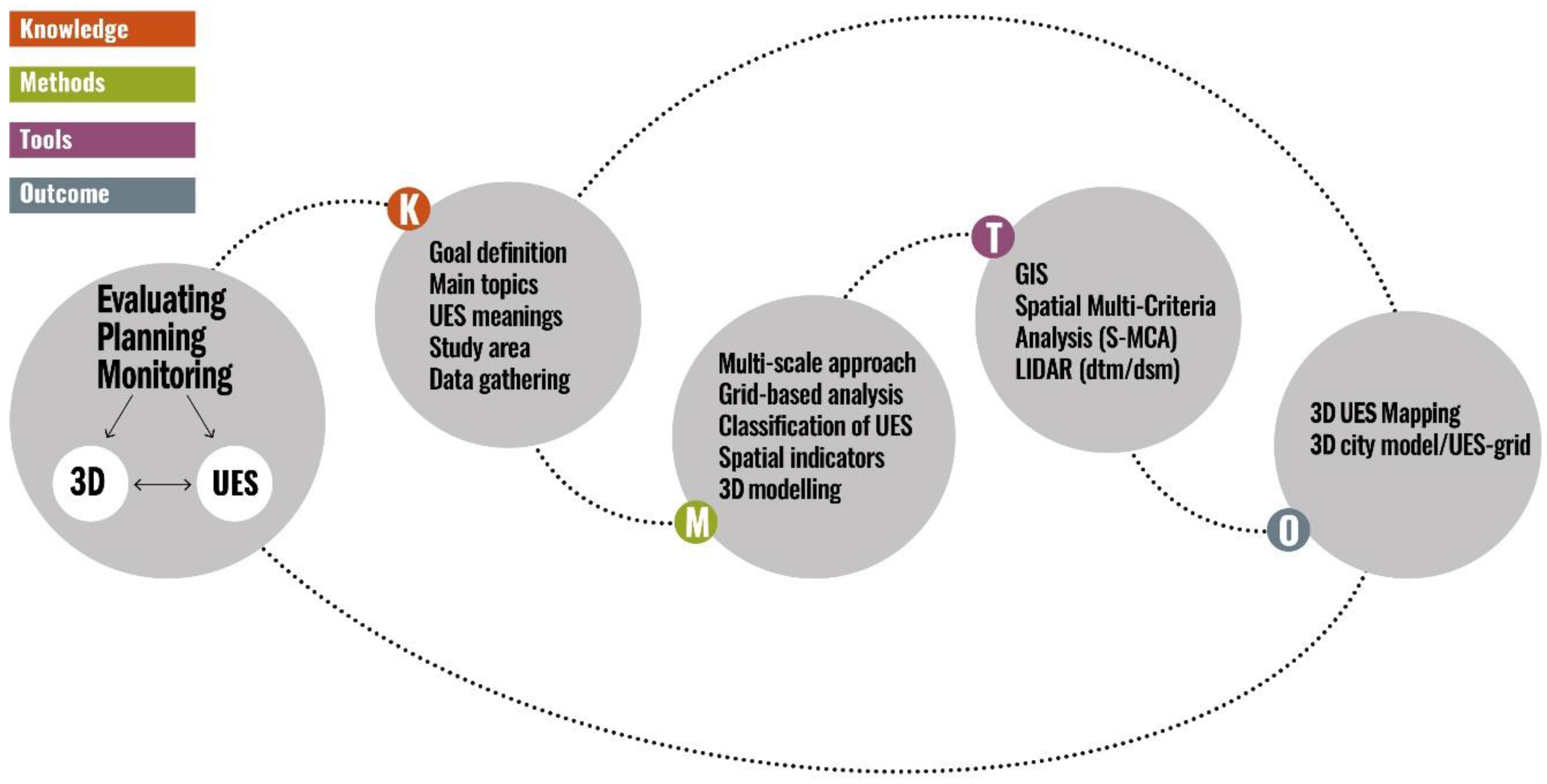
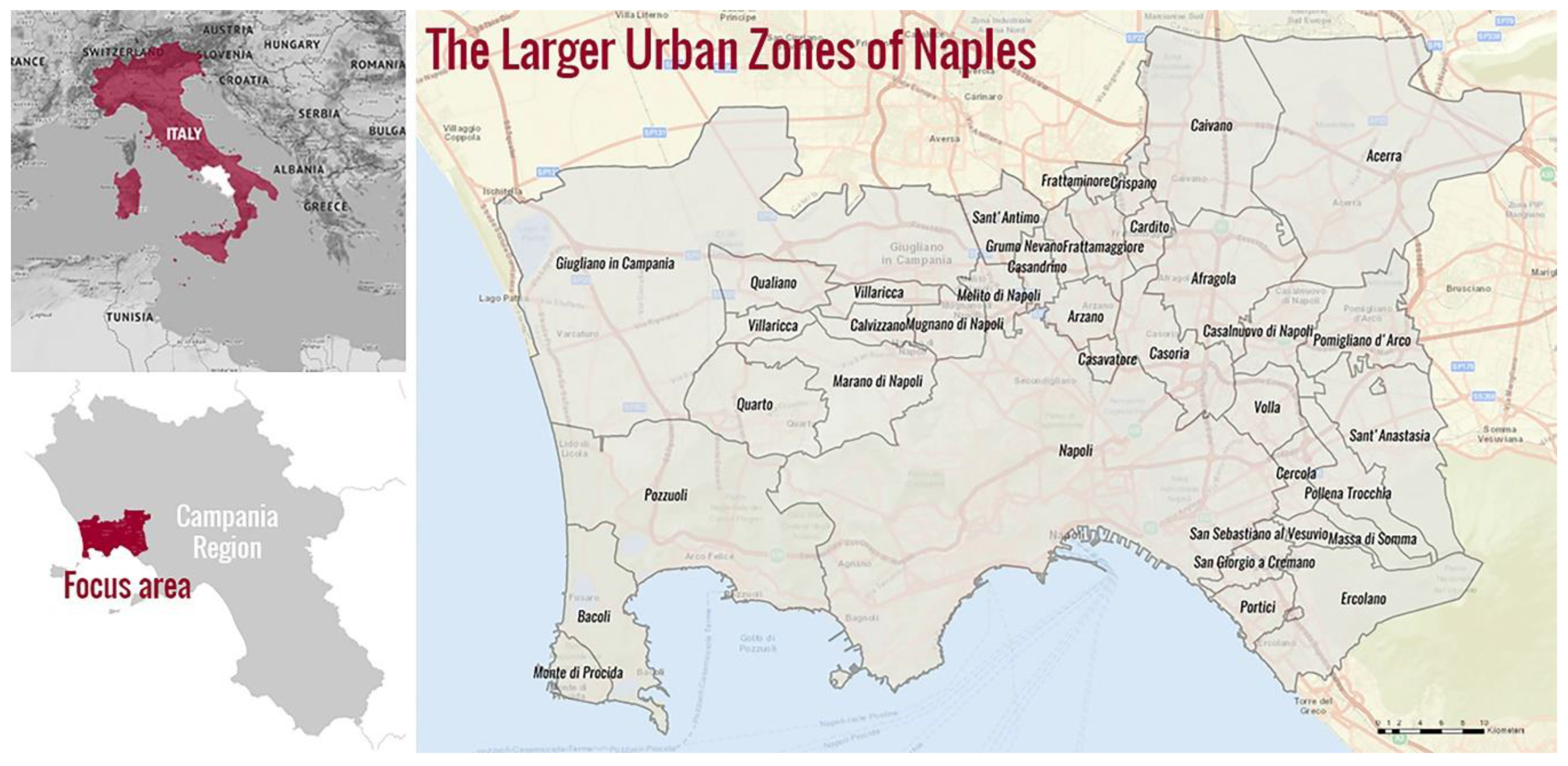
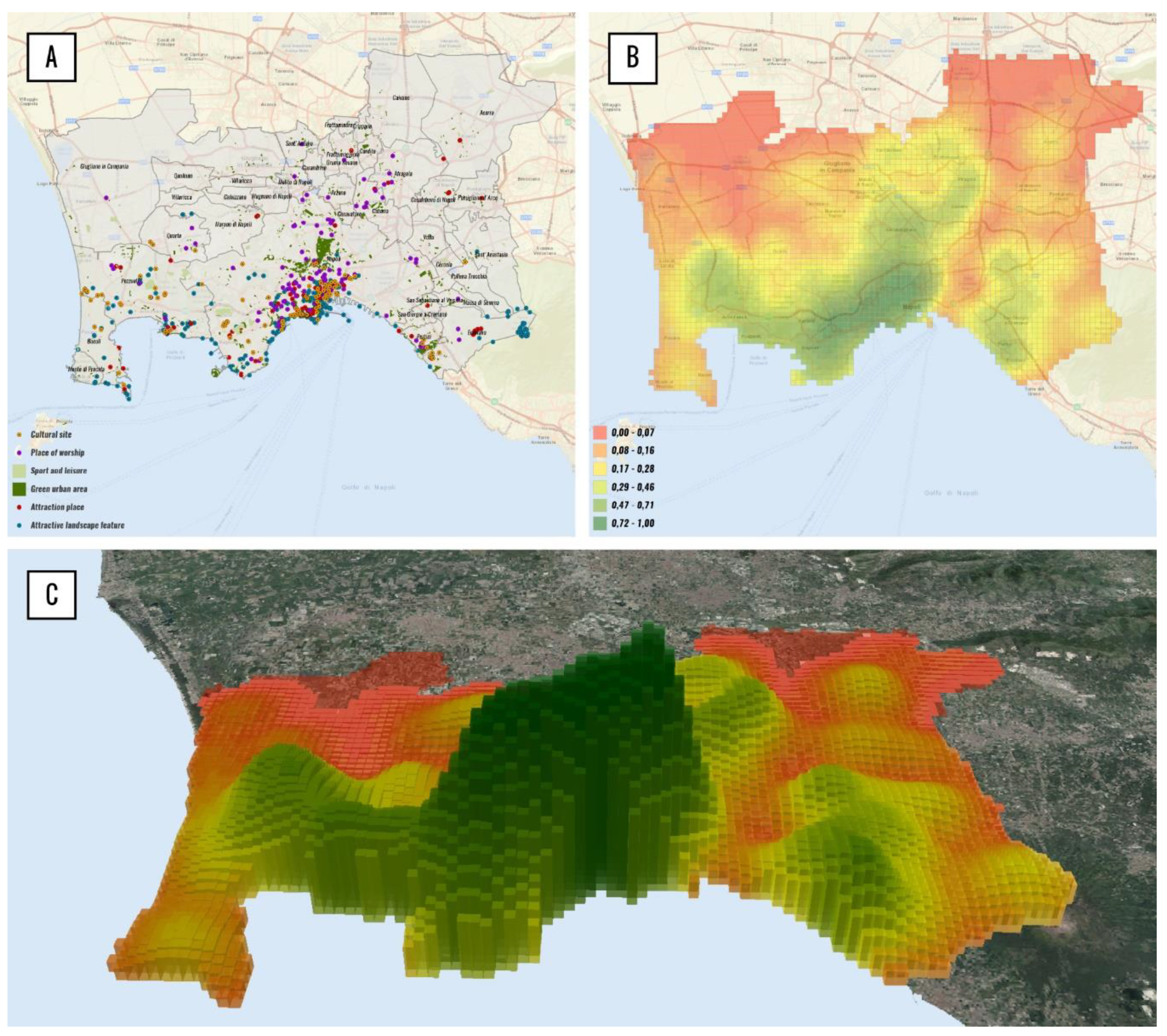
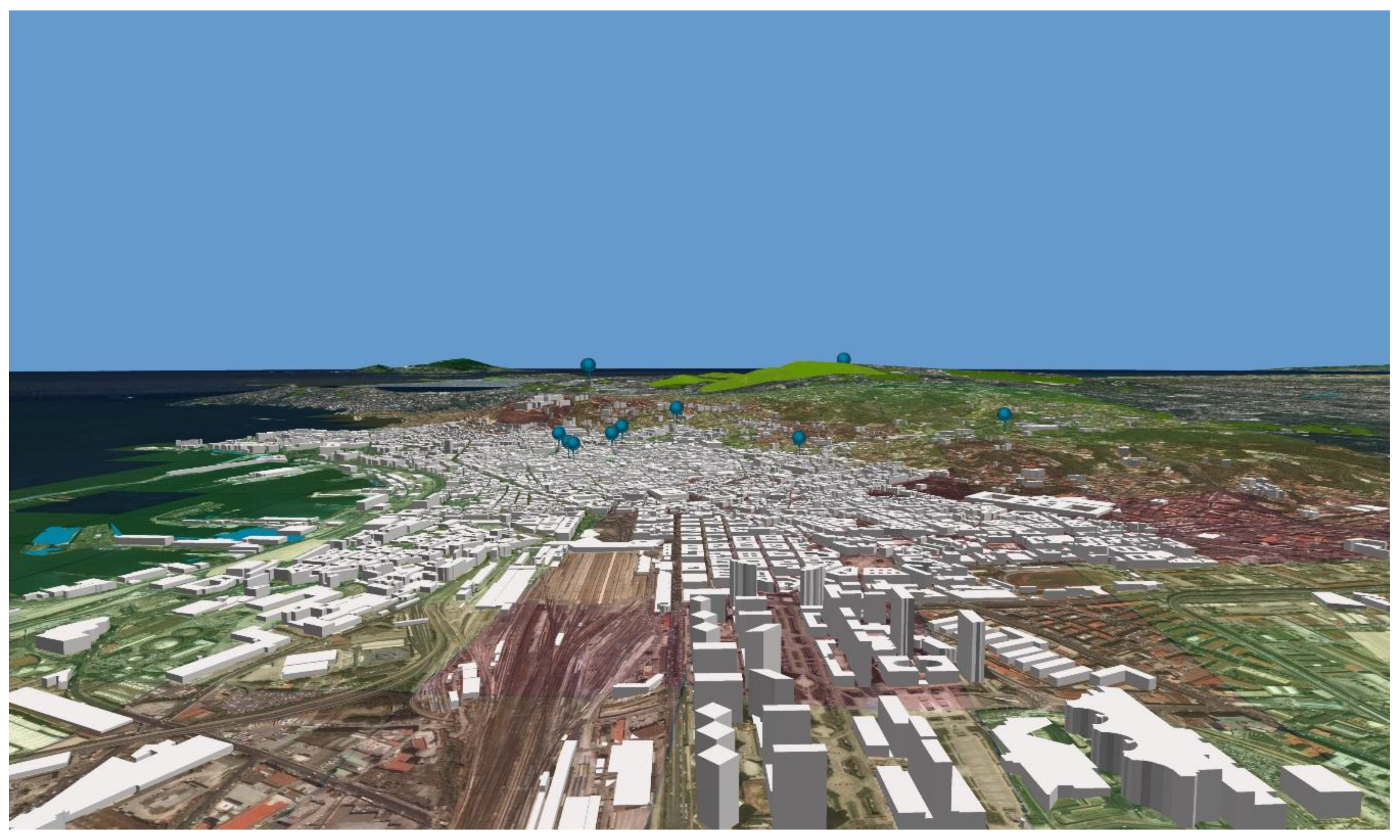
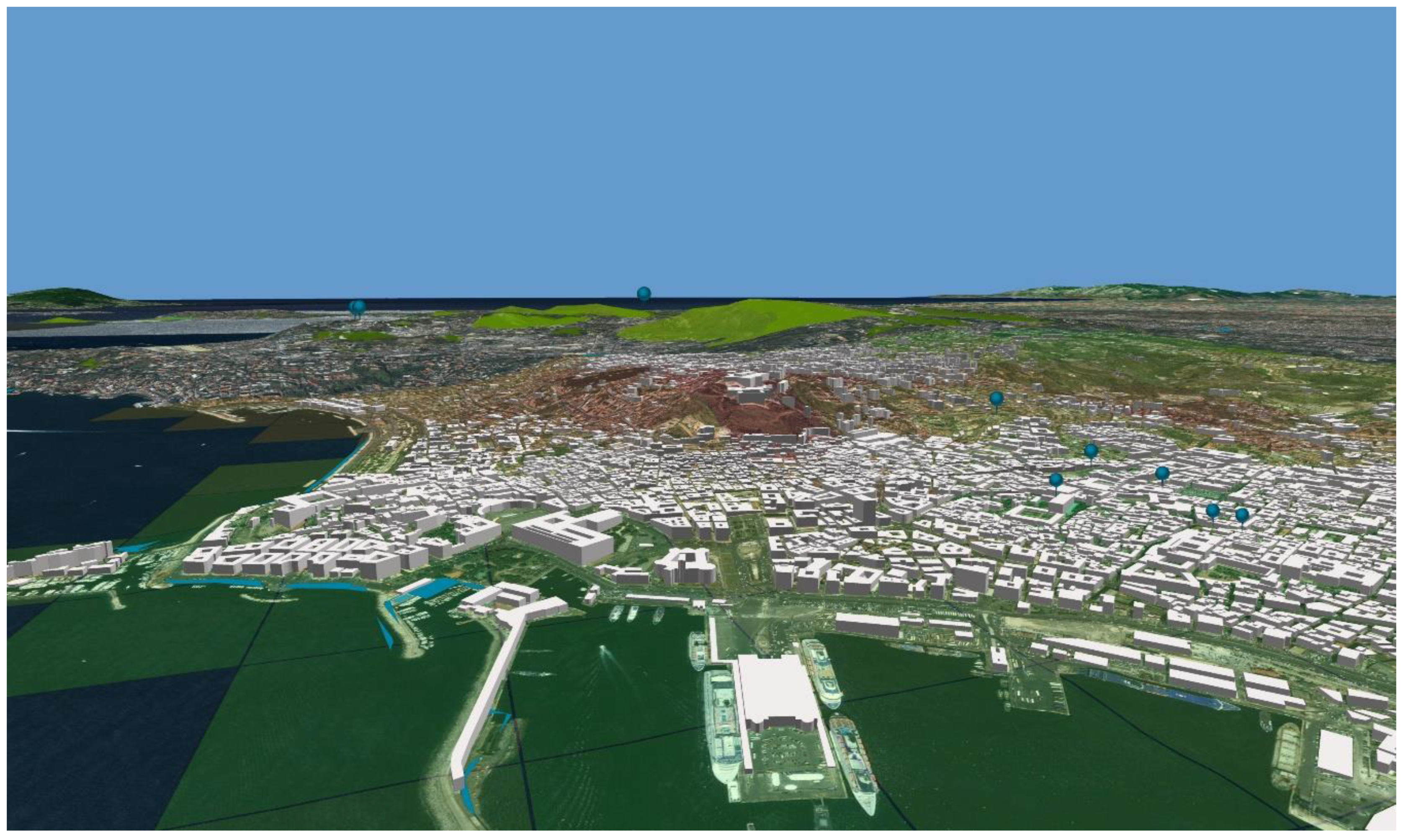
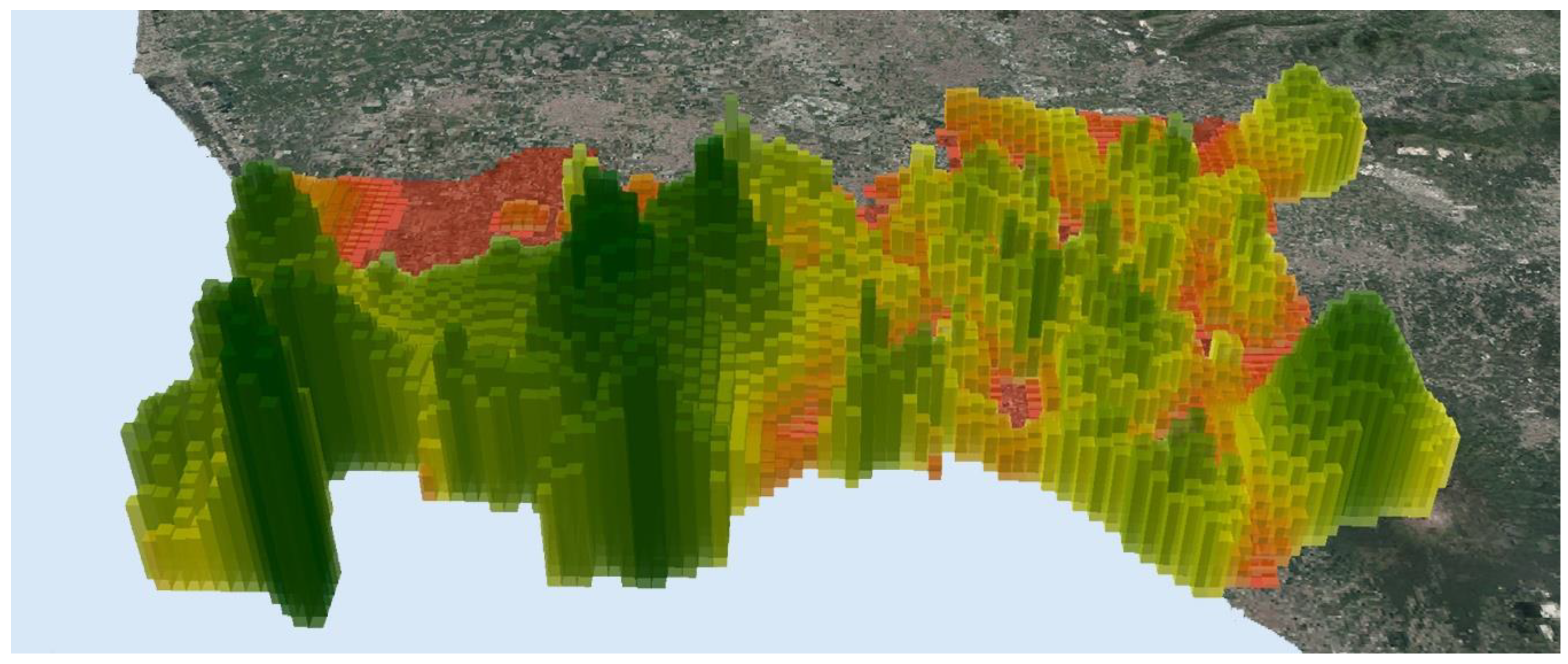
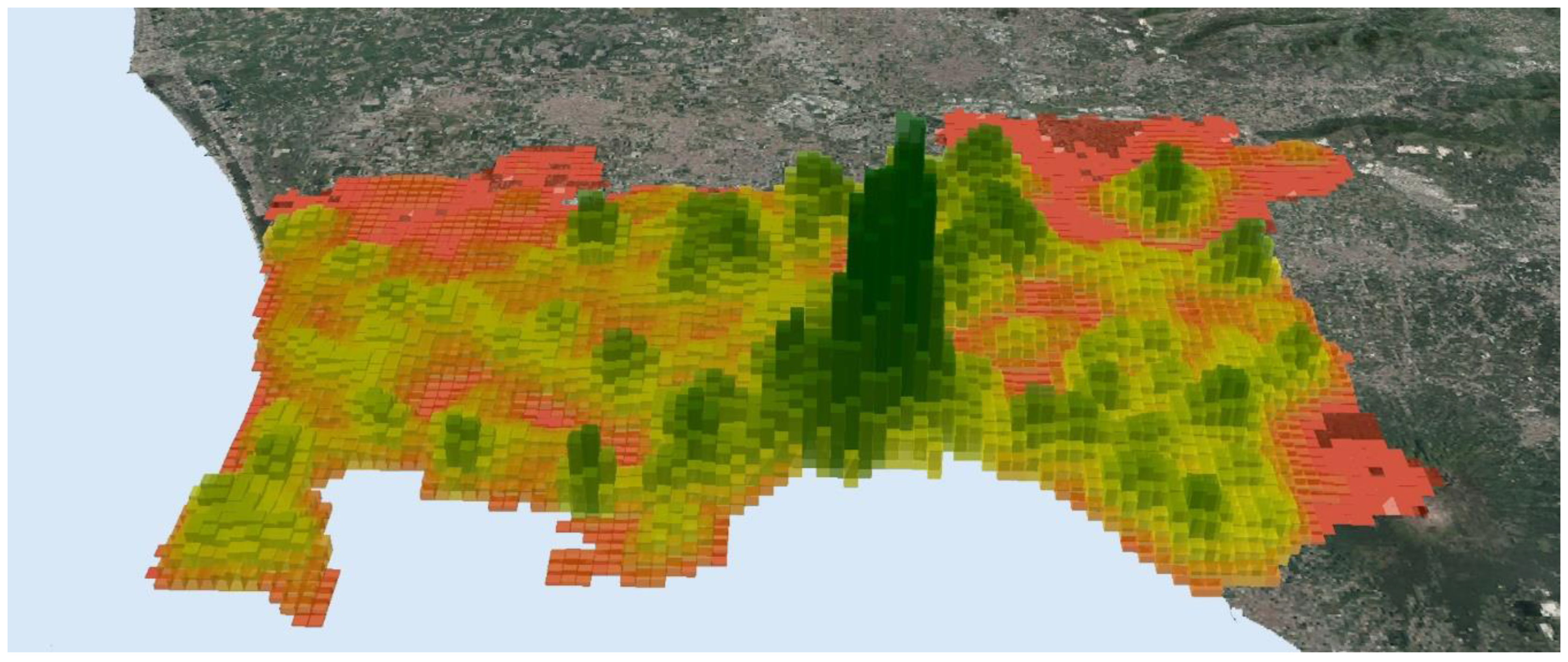

| Urban Ecosystem Service Functions | Tier | Unit of Measure | Geometric Entity | Distance Threshold (DT) | Source |
|---|---|---|---|---|---|
| Regulation | Environmental protection area | Sq. km | Polygon | 2500 | Natura 2000—EC |
| Waterbody | Sq. km | Polygon | 300 | Urban Atlas—EEA | |
| Forest | Sq. km | Polygon | 2500 | Urban Atlas—EEA | |
| Land without current use | Sq. km | Polygon | 100 | Urban Atlas—EEA | |
| Waterway | Km | Line | 300 | OpenStreetMap | |
| Carrier | Railway | Km | Line | 100 | OpenStreetMap |
| Road | Km | Line | 100 | OpenStreetMap | |
| Airport | Sq. km | Polygon | 1000 | Urban Atlas—EEA | |
| Port | Sq. km | Polygon | 1000 | Urban Atlas—EEA | |
| Bus/underground stop | Number | Point | 500 | OpenStreetMap | |
| Mineral extraction site | Sq. km | Polygon | 100 | OpenStreetMap | |
| Habitation density | Buildings per sq. km | Polygon | 100 | Urban Atlas—EEA | |
| Waste disposal | Sq. km | Polygon | 100 | OpenStreetMap | |
| Tourism facility | Number | Point | 500 | OpenStreetMap | |
| Information | Cultural site | Number | Point | 2000 | OpenStreetMap |
| Place of worship | Number | Point | 500 | OpenStreetMap | |
| Sport and leisure | Sq. km | Polygon | 500 | Urban Atlas—EEA | |
| Green urban area | Sq. km | Polygon | 1000 | Urban Atlas—EEA | |
| Attraction place | Number | Point | 500 | OpenStreetMap | |
| Attractive landscape feature | Number | Point | 1000 | Panoramio/Flickr |
| Municipality | Regulation Function | Carrier Function | Information Function | ||||||
|---|---|---|---|---|---|---|---|---|---|
| Min | Max | St. Dev. | Min | Max | St. Dev. | Min | Max | St. Dev. | |
| Acerra | 0.000 | 0.460 | 0.104 | 0.000 | 0.298 | 0.051 | 0.000 | 0.142 | 0.036 |
| Afragola | 0.000 | 0.372 | 0.105 | 0.000 | 0.271 | 0.078 | 0.015 | 0.298 | 0.084 |
| Arzano | 0.008 | 0.259 | 0.057 | 0.004 | 0.214 | 0.062 | 0.120 | 0.343 | 0.064 |
| Bacoli | 0.127 | 0.987 | 0.184 | 0.003 | 0.178 | 0.044 | 0.042 | 0.202 | 0.034 |
| Caivano | 0.000 | 0.255 | 0.061 | 0.000 | 0.272 | 0.063 | 0.000 | 0.188 | 0.044 |
| Calvizzano | 0.000 | 0.476 | 0.130 | 0.042 | 0.206 | 0.053 | 0.044 | 0.133 | 0.022 |
| Cardito | 0.064 | 0.361 | 0.084 | 0.080 | 0.232 | 0.037 | 0.152 | 0.213 | 0.017 |
| Casalnuovo di Napoli | 0.000 | 0.372 | 0.095 | 0.005 | 0.115 | 0.028 | 0.025 | 0.116 | 0.022 |
| Casandrino | 0.012 | 0.296 | 0.084 | 0.004 | 0.252 | 0.076 | 0.121 | 0.250 | 0.030 |
| Casavatore | 0.017 | 0.268 | 0.074 | 0.119 | 0.259 | 0.040 | 0.253 | 0.387 | 0.037 |
| Casoria | 0.000 | 0.462 | 0.108 | 0.007 | 0.260 | 0.075 | 0.025 | 0.315 | 0.091 |
| Cercola | 0.004 | 0.324 | 0.092 | 0.050 | 0.164 | 0.029 | 0.135 | 0.253 | 0.032 |
| Crispano | 0.000 | 0.221 | 0.066 | 0.001 | 0.261 | 0.083 | 0.055 | 0.212 | 0.049 |
| Ercolano | 0.000 | 0.648 | 0.178 | 0.000 | 0.218 | 0.055 | 0.051 | 0.351 | 0.061 |
| Frattamaggiore | 0.000 | 0.298 | 0.081 | 0.011 | 0.262 | 0.071 | 0.105 | 0.213 | 0.027 |
| Frattaminore | 0.000 | 0.221 | 0.073 | 0.009 | 0.234 | 0.072 | 0.049 | 0.191 | 0.040 |
| Giugliano in Campania | 0.000 | 0.672 | 0.116 | 0.000 | 0.211 | 0.043 | 0.000 | 0.248 | 0.042 |
| Grumo Nevano | 0.000 | 0.105 | 0.036 | 0.018 | 0.200 | 0.058 | 0.121 | 0.197 | 0.023 |
| Marano di Napoli | 0.000 | 0.608 | 0.191 | 0.021 | 0.204 | 0.037 | 0.010 | 0.143 | 0.037 |
| Massa di Somma | 0.040 | 0.633 | 0.189 | 0.000 | 0.231 | 0.072 | 0.068 | 0.208 | 0.036 |
| Melito di Napoli | 0.021 | 0.306 | 0.081 | 0.019 | 0.205 | 0.044 | 0.111 | 0.282 | 0.040 |
| Monte di Procida | 0.127 | 0.473 | 0.110 | 0.003 | 0.154 | 0.041 | 0.047 | 0.130 | 0.025 |
| Mugnano di Napoli | 0.014 | 0.497 | 0.120 | 0.060 | 0.264 | 0.049 | 0.087 | 0.251 | 0.038 |
| Napoli (Naples) | 0.000 | 1.000 | 0.216 | 0.002 | 1.000 | 0.143 | 0.031 | 1.000 | 0.245 |
| Pollena Trocchia | 0.000 | 0.540 | 0.127 | 0.000 | 0.184 | 0.049 | 0.061 | 0.197 | 0.035 |
| Pomigliano d’Arco | 0.000 | 0.330 | 0.082 | 0.000 | 0.261 | 0.058 | 0.002 | 0.116 | 0.027 |
| Portici | 0.018 | 0.355 | 0.115 | 0.021 | 0.192 | 0.044 | 0.189 | 0.393 | 0.060 |
| Pozzuoli | 0.093 | 0.693 | 0.113 | 0.001 | 0.206 | 0.035 | 0.067 | 0.423 | 0.094 |
| Qualiano | 0.000 | 0.171 | 0.039 | 0.005 | 0.260 | 0.069 | 0.004 | 0.129 | 0.039 |
| Quarto | 0.000 | 0.464 | 0.155 | 0.038 | 0.150 | 0.025 | 0.008 | 0.203 | 0.054 |
| San Giorgio a C. | 0.000 | 0.329 | 0.093 | 0.048 | 0.183 | 0.032 | 0.195 | 0.357 | 0.036 |
| S. Sebastiano al V. | 0.000 | 0.603 | 0.170 | 0.023 | 0.247 | 0.061 | 0.089 | 0.254 | 0.057 |
| Sant’Anastasia | 0.000 | 0.372 | 0.082 | 0.000 | 0.208 | 0.043 | 0.020 | 0.161 | 0.036 |
| Sant’Antimo | 0.002 | 0.321 | 0.099 | 0.016 | 0.252 | 0.070 | 0.026 | 0.207 | 0.051 |
| Villaricca | 0.000 | 0.167 | 0.052 | 0.016 | 0.206 | 0.053 | 0.004 | 0.135 | 0.041 |
| Volla | 0.000 | 0.374 | 0.092 | 0.005 | 0.152 | 0.041 | 0.027 | 0.257 | 0.063 |
© 2020 by the authors. Licensee MDPI, Basel, Switzerland. This article is an open access article distributed under the terms and conditions of the Creative Commons Attribution (CC BY) license (http://creativecommons.org/licenses/by/4.0/).
Share and Cite
Cerreta, M.; Mele, R.; Poli, G. Urban Ecosystem Services (UES) Assessment within a 3D Virtual Environment: A Methodological Approach for the Larger Urban Zones (LUZ) of Naples, Italy. Appl. Sci. 2020, 10, 6205. https://doi.org/10.3390/app10186205
Cerreta M, Mele R, Poli G. Urban Ecosystem Services (UES) Assessment within a 3D Virtual Environment: A Methodological Approach for the Larger Urban Zones (LUZ) of Naples, Italy. Applied Sciences. 2020; 10(18):6205. https://doi.org/10.3390/app10186205
Chicago/Turabian StyleCerreta, Maria, Roberta Mele, and Giuliano Poli. 2020. "Urban Ecosystem Services (UES) Assessment within a 3D Virtual Environment: A Methodological Approach for the Larger Urban Zones (LUZ) of Naples, Italy" Applied Sciences 10, no. 18: 6205. https://doi.org/10.3390/app10186205
APA StyleCerreta, M., Mele, R., & Poli, G. (2020). Urban Ecosystem Services (UES) Assessment within a 3D Virtual Environment: A Methodological Approach for the Larger Urban Zones (LUZ) of Naples, Italy. Applied Sciences, 10(18), 6205. https://doi.org/10.3390/app10186205







